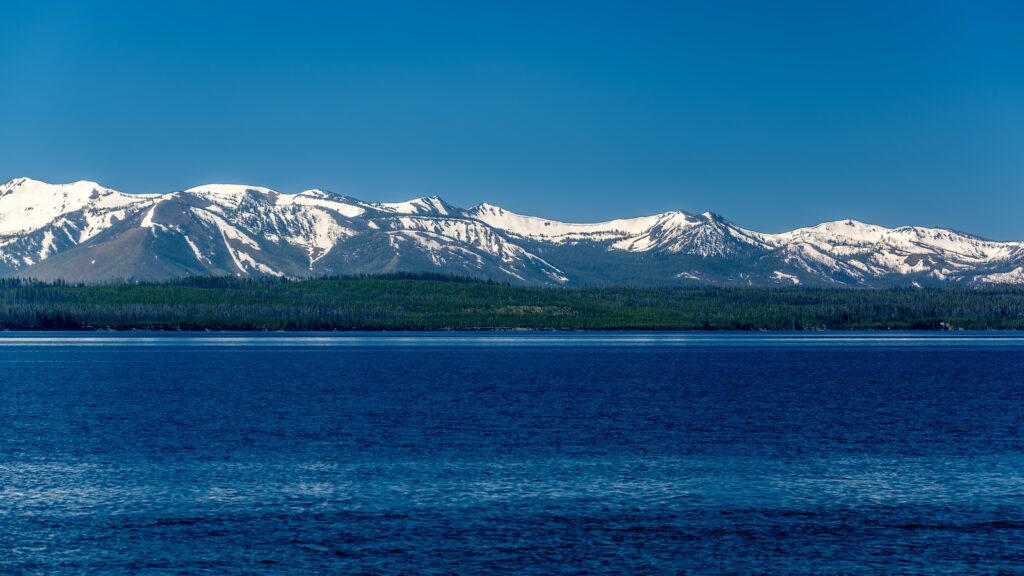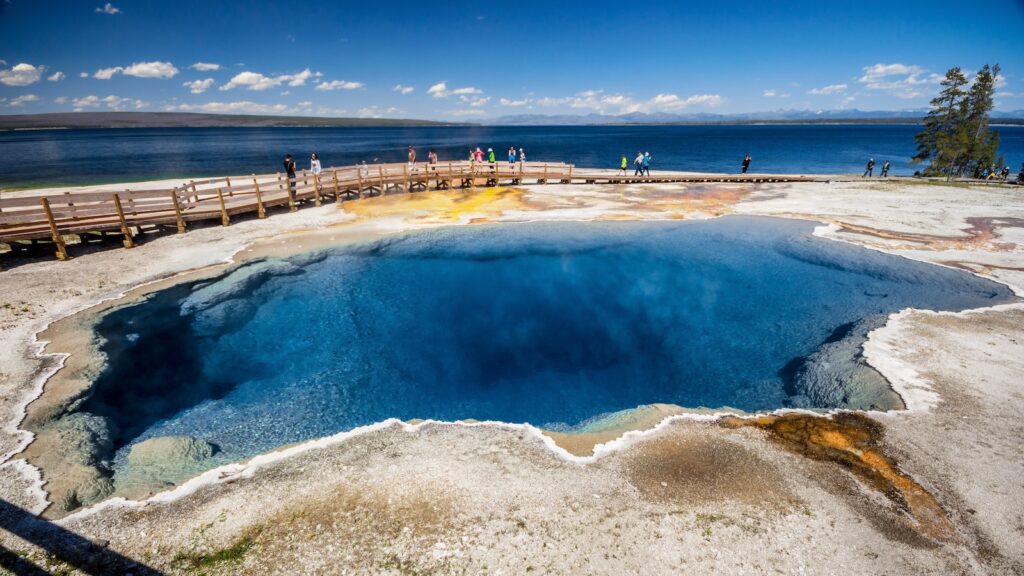Yellowstone National Park is America’s oldest national park and still one of its most dramatic. With untamed wildlife that keeps visitors on their toes, boiling mud pots, colorful hot springs, and geysers erupting like clockwork, this park offers up sights that can only be seen here.
Visitors to this amazingly wild national park are treated to sights like the famous Old Faithful geyser, which erupts like clockwork right outside of the popular Old Faithful Lodge. Wildlife lovers flock to areas like Hayden and Lamar Valley to catch a glimpse of some of America’s largest land mammals, like moose, bears, elk, and bison.
The stunning Grand Canyon of Yellowstone also has to be on everyone’s list, with stunning cliffs and majestic waterfalls.
So, if you’re looking for a vacation full of adventure and wonder, head to Yellowstone National Park to experience these stunning natural sights.
Old Faithful Geyser

Perhaps the park’s most famous feature, Old Faithful, erupts with remarkable regularity, shooting water and steam into the air in a spectacular display. Its convenient location right next to the Old Faithful Lodge makes this a very popular tourist spot.
There are actually a dozen geysers near the lodge, so if you have a bit of a break before the next eruption, it’s a great chance to walk around and check out the others. Out of the nearly 500 geysers in Yellowstone, there are six that park rangers currently predict.
Grand Prismatic Spring

This vibrantly colored hot spring is another extremely popular destination within Yellowstone National Park. Elevated boardwalks take you around the different pools, like the aptly named Opal and Turquois Pools. Make sure to stay on the boardwalks as the crust around the pools is thin and can collapse into the scalding waters below with no warning.
If you want a less trafficked view of the spring, hop on the Fairy Falls Trail. This 1.5-mile round-trip hike takes you up the hill behind the springs, where you can get a look at the springs from a higher vantage point.
Yellowstone Lake

Sitting at nearly 8,000 feet in elevation, this massive lake covers nearly 132 square miles and is home to the largest native population of cutthroat trout in North America. Despite its massive size, the lake’s surface freezes solid during the winter months and doesn’t fully thaw until late spring or early summer. This, plus its depth of over 300 feet in places, means the lake stays chilly all summer, so swimming is highly discouraged.
There are plenty of ways to get out on the lake to explore its shoreline or try your hand at catching one of its fabled trout. Yellowstone National Park Lodges offers tours, shuttle services, boat rentals, or you can bring your own boat.
Mammoth Hot Springs

Located near the northern edge of the park, Mammoth Hot Springs is a sight to behold with its huge stepped tiers of solidified calcium carbonate that flows up from deep underground. The terraces are divided into the Upper and Lower sections, each offering unique and breathtaking views. Visitors can explore the hot springs via boardwalks that provide close-up encounters with this amazing area.
Note that despite its name, there are no soaking pools within the hot springs due to their intense heat and damage caused to the features by human traffic.
Lower Falls of the Yellowstone River

In a park with no shortage of stunning waterfalls, the Lower Falls of the Yellowstone River stands out above the rest. Nestled in a part of the park known as the Grand Canyon of the Yellowstone, this waterfall cascades over 300 feet in the canyon floor below. A short loop drive takes visitors past four different lookout points, including a trail that leads you right to the top of the falls, so you can capture this majestic scene from every angle.
Grand Canyon of the Yellowstone

Home to the aforementioned Lower Falls, the Grand Canyon of the Yellowstone is an impressive canyon with walls that pop with pinks, yellows, and oranges from mineral deposits left behind by the volcanic vents along the canyon walls. This canyon is over 4,000 feet wide and up to 1,200 feet deep in places and has numerous viewpoints along the rim.
Unfortunately, the trail leading into the canyon and to the base of Lower Falls has been closed now for several years with no immediate plans of reopening.
Norris Geyser Basin

The Norris Geyser Basin holds one of the park’s largest and most diverse collection of thermal features. With bubbling mud pots, the tallest geyser in the park, hissing rocks, and even an acid geyser, this area is an absolute must-visit to get an up close and personal look at the hydrothermal activity of the park. There are over 2 miles of trails and elevated boardwalks that circle the two main parts of this area, the porcelain basin and the back basin, and we recommend you take the time to explore both.
Hayden Valley

If you’ve come to Yellowstone in search of wildlife then Hayden Valley is the best place to start your search. This large sub-alpine valley is closed to foot traffic which allows the animals of the park to peacefully roam and forage through this large swath of valley floor. There are plenty of lookouts along the road where visitors and photographers can set up shop to glass the floor and hillsides for bear, elk, coyotes, wolves, and bison.
If you want to get away from the road, there are two trails that cross through the area. The Howard Eaton Trail is a long point-to-point trail that runs along the eastern side of the valley. This trail is often closed due to bear activity, so be sure to check with the rangers ahead of time. The other is the Mary Peak trail, which leads you away from the valley along Alum Creek.
Tower Fall

This 132-foot waterfall near the terminus of the Grand Canyon of the Yellowstone played a part in Yellowstone being named America’s first national park. Artist Thomas Moran visited the area and painted a picture of the falls. This picture, among others, was presented to congress who shortly thereafter voted to preserve this incredible region for generations to come.
The fall itself is surrounded by eroded pinnacles that create a unique setting that is a favorite of park photographers. To catch a glimpse of the falls there is a short, paved trail to the falls overlook as well as a trail that continues along the creek to its confluence with the Yellowstone River.
Artist Paint Pots

This geothermal area features bubbling mud pots that create a colorful and otherworldly landscape reminiscent of an artist’s palette. A one-mile trail winds its way through these unique geothermal features, where you can watch the bubbles in the mud slowly form and pop and take in the sounds that this geothermal activity creates.
Mud pots are different from geysers and hot springs in that they have a very limited water supply so that, along with their high heat, lead to the thick mud you see in this area.
Lamar Valley

Lamar Valley is another of the park’s popular wildlife viewing areas and is often referred to as America’s Serengeti due to its population of large mammals. The valley is home to two wolf packs, so those hoping to catch a glimpse of one of these elusive animals should definitely pay a visit to this area. The valley is also home to bison, bears (both black and grizzly), coyotes, foxes, and deer.
This area is more accessible for hikers than Hayden Valley, as there are trails that run along the river and established backcountry campgrounds. But bring your bear spray, as you are almost certain to see bear activity in this area.
Mount Washburn

One of the most popular day hikes in the park, the Mount Washburn trail takes visitors up over 10,000 feet to the peak of this ancient volcano. Along the way you can expect stunning wildflower displays, bighorn sheep, and although it is not recommended, a hike in the fall months can lead to some up close encounters with grizzly bears.
If you choose to hike the trail, come prepared for a long day as the trail is 7 miles with nearly 1,400 feet of elevation gain. And with the trailhead sitting at nearly 9,000 feet, the thin air at this elevation will make everything feel more difficult. The views from the top of this peak are otherworldly, though, as you can see nearly 50 miles in every direction throughout the park.
Grand Geyser

Located close to Old Faithful this massive geyser is often overlooked by its more famous cousin. Shooting up to 200-feet in the air (taller than Old Faithful!), Grand Geyser is the tallest predictable geyser in the world!
West Thumb Geyser Basin

The West Thumb Geyser area has an interesting history in one of its most unique features. A natural hot spring located right next to the lake’s waterline, known as the Fishing Cone, was once used by fishermen back in the 1800s to cook fish, often still attached to the hook, as soon as they pulled them from the water! That practice has since been outlawed as who really wants fish cooked over a sulfur-smelling vent anyway?
The area is also home to numerous other hot springs, vents, and a pool named the Abyss for its seemingly bottomless appearance.
Fountain Paint Pot

Like the Artist Paint Pots earlier, the Fountain Paint Pots offer up another opportunity to see boiling mud pots, geysers, and hot springs within a small area. The trail’s raised boardwalks let you experience these natural features up close but, like all of these thermal features, stay on the trail or risk breaking through the crust into the boiling waters below!
